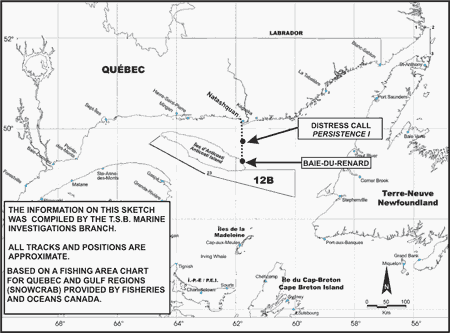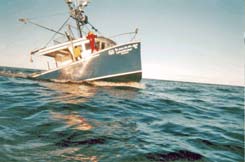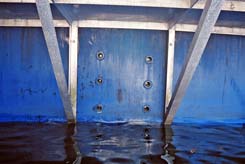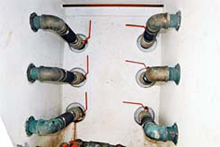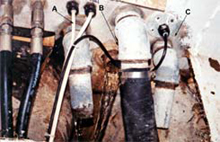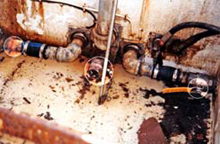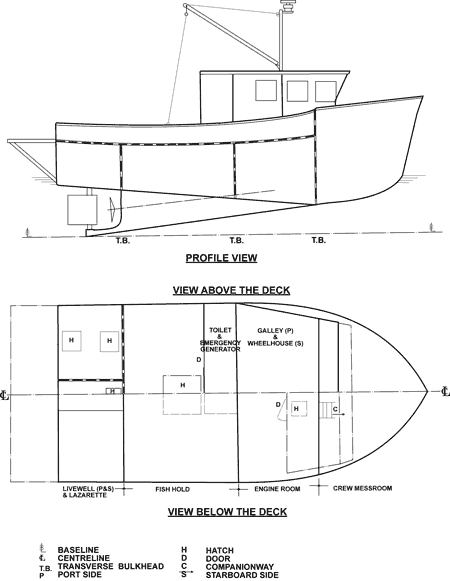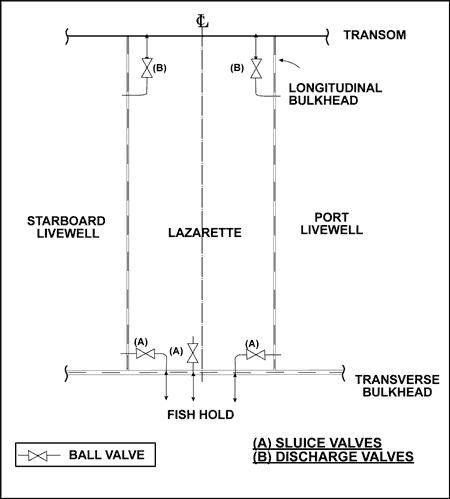Flooding
Aboard the fishing vessel Persistence I
Off Natashquan, Quebec
The Transportation Safety Board of Canada (TSB) investigated this occurrence for the purpose of advancing transportation safety. It is not the function of the Board to assign fault or determine civil or criminal liability. This report is not created for use in the context of legal, disciplinary or other proceedings. See Ownership and use of content. Masculine pronouns and position titles may be used to signify all genders to comply with the Canadian Transportation Accident Investigation and Safety Board Act (S.C. 1989, c. 3).
Summary
On the evening of 16 June 2004, the Persistence I sailed from Baie-du-Renard, Quebec, on Anticosti Island, Quebec, on a course to Natashquan, Quebec. En route, the seawater circulation system for the live-well tanks was started to preserve the catch. After a few hours under way, the operator noticed that the fishing vessel was not handling as usual. Upon conducting an inspection, he discovered that the after part of the vessel had settled lower in the water and that water had flooded into the aft compartments. The operator broadcast an urgency communication prefixed PAN PAN.
The Marine Communications and Traffic Services at Rivière-au-Renard, Quebec, received the message and transmitted a Mayday Relay. A search and rescue operation was launched that included a Canadian Coast Guard ship (CCGS), and a Canadian Forces aircraft and helicopter. The CCGS Cap de Rabast and the Violaine.C.I located the Persistence I and escorted it to Natashquan. Although the afterdeck was gradually sinking below the surface, the operator managed to reach port at Natashquan and to beach the vessel near the wharf at 0525 eastern daylight time on June 17.
Factual information
Particulars of the vessel
| Name | "PERSISTENCE I" |
|---|---|
| Official number | 823810 |
| Port of registry | Yarmouth, Nova Scotia |
| Flag | Canada |
| Type | Fishing vessel |
| Gross tonnageFootnote 1 | 47.42 |
| Length | 12.21 m |
| Cargo | 5100 kg of crab and 590 kg of lobster |
| Persons on board | Six crew members and three company employees |
| Built | Composite materials at Lower East Pubnico, Nova Scotia, in 2001 |
| Propulsion | One 298 kW diesel engine driving a fixed-pitch propeller |
| Owner | Regroupement Mamit Innuat inc., Mingan, Quebec |
Description of the vessel
The Persistence I is a decked fishing vessel, built of composite materials, that is used primarily for crab fishing. The hull is divided into four compartments that are separated by three transverse bulkheads (see Appendix A). Starting from the bow, it consists of the crew's messroom, the engine room, the fish hold, and the aft compartment, which includes a live-well tank on either side of the lazarette.
The main deck has a superstructure that houses the wheelhouse at the front. The fishing vessel is also fitted with a seawater circulation system for the live-well tanks, a bilge pumping system, and a water level alarms system. Access to the afterdeck, from the wheelhouse, is through a hinged door with a sill of about 25 mm, although regulations require a minimum of 300 mm.
History of the voyage
On 15 June 2004, the fishing vessel Persistence I sailed from the wharf at Natashquan, Quebec, for fishing area 12B with six crew members including the operator (see Figure 1). After catching 5100 kg of crab on June 16, the vessel left the fishing area and headed for Natashquan. During the return voyage, the operator received a request from the company to call at Anticosti Island before returning to Natashquan. Consequently, around 1830 eastern daylight time,Footnote 2 at Baie-du-Renard (Anticosti Island), an aluminum launch, two outboard motors, and 590 kg of lobster distributed in 13 crates were loaded, and three company employees boarded.
Soon after leaving, the crates of lobster were stowed in the port live-well tank and the seawater circulation system was started to preserve the catch. During the evening, the operator inspected the afterdeck and everything seemed normal.
On 17 June 2004, around 0030, in calm seas, the operator, who was in the wheelhouse, noticed a change in the vessel's handling. He went to the afterdeck and noticed that the vessel had a pronounced trim by the stern. The water level alarm had not sounded in the wheelhouse. He proceeded forward and turned off the seawater circulation system for the live-well tanks and then returned to the lazarette to close the discharge valves. Upon opening the lazarette hatch, he saw that the compartment had flooded and that he could not access the discharge valves.
From the wheelhouse, the operator ordered the crew to put on their immersion suits and to gather on the forecastle. At 0100, the operator broadcast an urgency call prefixed PAN PAN to the Marine Communications and Traffic Services (MCTS) at Rivière-au-Renard, on channel 16 very high frequency (VHF), and informed them that the Persistence I was located in 49°49.51′ N, 061°51.95′ W, north of Anticosti Island, and immediate assistance was required. At 0108, the MCTS broadcast a Mayday Relay. The crew members gathered on deck and carried the liferaft to the forecastle in preparation to evacuate.
At 0128, the CCGS Cap de Rabast sailed from Havre-Saint-Pierre, Quebec, to the Persistence I. Hercules aircraft R323 and Cormorant helicopter R908 from Greenwood, Nova Scotia, were dispatched to the site.
Meanwhile, the operator used the satellite telephone to inform the company's fishing director of the situation. The director requested the fishing vessel Violaine.C.I to assist the Persistence I. Around 0130, the Violaine.C.I sailed from Natashquan to meet the Persistence I. Upon rendez-vous around 0320, the operator of the Persistence I requested the Violaine.C.I to come alongside to effect crew transfer. However, the operator of the Violaine.C.I rejected this approach on the grounds that the fishing gear would interfere with the safe execution of the manoeuvre. It was then decided to launch and use the Persistence I's seven-person liferaft to transfer the crew. To carry out this manoeuvre, the Persistence I's current speed, estimated at about four knots, was maintained to prevent the vessel's stern from sinking further into the water. The crew of the Persistence I deployed the liferaft, but it capsized. In the prevailing conditions, the crew experienced difficulty in holding onto the liferaft painter and it was let go. The liferaft drifted away and it was later recovered by the Violaine.C.I. The plan to transfer the crew was now abandoned. At some point, the fish hold hatch cover was lost overboard.
Around 0345, the Hercules aircraft R323 arrived at the site and flew over the sector. Around 0418, the Persistence I reached the approaches to the Natashquan River, and at 0437, the CCGS Cap de Rabast arrived on scene. Upon arrival on scene and with the situation under control, the commanding officer of the CCGS Cap de Rabast informed the helicopter pilot that their services were no longer required. The helicopter returned to base.
Because the afterdeck was completely submerged, it was felt that towing was not appropriate. The CCGS Cap de Rabast approached on the port shoulder of the Persistence I and seven of the nine people transferred to the CCGS Cap de Rabast. The operator and one crew member stayed aboard to pilot the Persistence I. The captain of the CCGS Cap de Rabast called off the mission of the R323 aircraft and requested the Violaine.C.I to continue its escort into port. The crew member who stayed with the vessel gave the operator an immersion suit, supplied by the CCGS Cap de Rabast. Around 0525, the operator headed the vessel onto a cayFootnote 3 about 15 m north of the Natashquan wharf. The vessel was successfully beached. The discharge valves in the lazarette were immediately closed, and a submersible pump was installed. Around 0620, the Persistence I was refloated, and at 0630, it was moored to the wharf.
Safety culture among fishers
Reporting and investigating marine occurrences to determine causes and contributing factors is one of the means of enhancing safety and indicates a positive safety culture. In the case of the Persistence I, similar occurrences took place in spring 2002 and again in May 2004 when the fish hold flooded after the seawater circulation system for the live-well tanks was started. Neither of these occurrences were investigated by the company and the first occurrence was not reported to authorities.
The lack of a safety culture among fishers has been noted in a number of TSB reports.Footnote 4 In 2003, the Board recommended that
Transport Canada, in coordination with Fisheries and Oceans Canada, fisher associations and training institutions, develop a national strategy for establishing, maintaining and promoting a safety culture within the fishing industry.
Transportation Safety Recommendation M03-02 (issued September 2003)
It is recognized that the attitudes toward and beliefs about risk form the basis of an effective safety culture. However, developing this safety culture will require a long-term effort to promote positive attitudes toward safety within the fishing community. In the interim, fishers will continue to be at risk. To mitigate the risk, the Board issued a second recommendation (in the same year) that
The Department of Transport, in collaboration with the fishing community, reduce unsafe practices by means of a code of best practices for small fishing vessels, including loading and stability, and that its adoption be encouraged through effective education and awareness programs.
Transportation Safety Recommendation M03-07 (issued November 2003)
Some action has been taken by Transport Canada toward developing a safety culture among the fishing community.Footnote 5
Professionalization of fishers and fisher's helpers in Quebec
Since the Act respecting the Bureau d'accréditation des pêcheurs et des aides-pêcheurs du Québec was introduced in 1999, the Bureau d'accréditation des pêcheurs et des aides-pêcheurs du Québec (BAPAP) has been the legal authority for professionalizing all fishers. The regulations pursuant to this Act give the BAPAP the responsibility to
- issue and update record books for fishers and fisher's helpers;
- issue certificates for fishers, fisher's helpers, and apprentice fishers attesting to the aptitude of individuals to exert their trade according to the requirements of commercial fishing;
- grant exemptions as required; and
- administer annual fees.
To help achieve its objectives, the BAPAP has asked the Department of Fisheries and Oceans that issuing fishing licenses be linked to crew certification. However, to date, no concrete measures have been instituted to address this concern.
The company and all crew members, including the operator, expressed interest in participating in the professionalization program for fishers and fisher's helpers; however, no action has been taken to ensure follow-up on skills and training.
Policy regarding certificates of competency
Although Transport Canada issues fishing master certificates, they are not required for the majority of mariners whose main employment is commercial fishing as about 94 per cent of all fishing vessels registered are vessels with a gross tonnage of 60 or less. The only training that these uncertificated mariners have to take is a Marine Emergency Duties (MED) course, and this minimum requirement will not be mandatory before 2007. The Ship Station (Radio) Technical Regulations require certification to operate VHF equipment.
Expertise of personnel
At the time of the occurrence, the operator had 20 years of experience on fishing vessels and had been working as the operator of the Persistence I since April 2004. In February 2003, he had taken the MED A1 training, but he did not hold a fishing master certificate.
All the other crew members had also taken MED training.
Seawater circulation system for the live-well tanks
A mechanical pump located in the engine room supplies sea water to the live-well tanks, which are designed to service three tiers of lobster crates. A pipe fitted with a discharge valve, mounted on the transom at each tier level, maintains an appropriate water level in the live-well tanks. The valves, which are located in the lazarette, cannot be remotely operated (see photo 2 and photo 3). There is no physical barrier to prevent the use of this system.
Bilge pumping system
The bilge pumping system for the engine room comprised one hydraulically driven pump and one electric submersible pump. The fish hold is also equipped with electric submersible pumps that, together with the engine room electric pump, can be operated automatically or manually from the wheelhouse. The crew's messroom and the aft compartment are not fitted with a bilge pumping system. To dewater the aft compartment, the water is drained by gravity through three pipes and sluice valves to the fish hold (see photo 4 and photo 5).
High water level alarm system
Although not required by the Small Fishing Vessel Inspection Regulations (SFVIR),Footnote 6 a high water level alarm system with audible and visual warning signals is fitted in the wheelhouse. The system is powered from a circuit breaker located in the wheelhouse electrical distribution panel. Alarm detectors are installed in the lazarette, fish hold, and engine room. Following the occurrence, the system was tested. Contrary to its design, the alarm remained activated although the compartments were dry.
Inspection regime for small fishing vessels
The SFVIR govern construction and inspection of small fishing vessels to ensure that they remain seaworthy. The inspection program includes the following steps:
- submission in triplicate of documents related to the vessel (more often than not in the form of plans) to a Transport Canada (TC) Centre;
- review of the documents by the Marine Safety Branch at a TC Centre (approved documents will bear a seal of certification and approval);
- inspection during construction and follow-up testing of the vessel by an inspector from TC's Marine Safety Branch to ensure compliance with the approved plans; and
- issue of an inspection certificate by a TC inspector once all the regulatory provisions applicable to the vessel have been met.
In this instance, on 29 April 1998, the builder submitted generic plans for the construction of a class of hull to the TC Centre in the Atlantic region, and these were used for the construction of the Persistence I. Those plans included a plan of the
- longitudinal section,
- beams and framework,
- details and laminating, and
- details.
On 09 July 1998, the Technical Services Division at the regional TC Centre approved the documents subject to notations in red. A review of the plans showed these items among those notations:
- Additional information required by Schedule 1 of the SFVIR to be submitted.
- Bulkhead between the fish hold and the aft compartment must be watertight.
A copy of the plans was submitted to the builder and another was submitted to the TC Centre in the district where the Persistence I was built and inspected.
This district is subdivided into four sectors with one inspector assigned to each sector. Since the inspectors have various specialties, vessels under construction are sometimes inspected by an inspector whose primary expertise does not correspond to the aspect of construction being inspected.
During construction in 2001, the shipyard submitted a proposal to TC to fit out live-well tanks. TC responded by mail to the shipyard that such an addition would require an inclining experiment and the presentation of a stability booklet for approval. These conditions were not followed up.
On 09 July 2001, construction of the Persistence I was completed with the fitting out of live-well tanks. The inspector issued an Inspection Certificate for a Commercial Fishing Vessel valid until 08 July 2005 with an annotation in English prohibiting the operator from using the live-well tanks.
On 02 October 2001, TC again notified the owner by mail that the live-well tanks should not be used unless the adequacy of the stability had been shown.
On 16 October 2003, the owner made changes to the lifesaving equipment to allow the vessel to carry seven people instead of four. The inspection certificate was modified to reflect this, but the certificate was not posted on board.
Transfer of ownership
The Persistence I was operated for one season in the Maritimes region until it was purchased by the Regroupement Mamit Innuat inc. on 01 May 2002. The information concerning the transfer was entered in the Ship Registration Information System by the registrar at the TC Centre in Québec, Quebec, but the Marine Safety Branch in Québec was not aware of the transfer.
Analysis
Risk management system
In this instance, the company did not have a specific policy concerning crew hiring and training. A good understanding of the shipboard operating systems and vessel operation would have provided the ship's complement with information to help handle an on-board emergency and a better appreciation of the developing emergency situation.
Since there was no on-board inspection regime, the operation of the high water alarm system was not checked regularly. Consequently, the crew did not know that the only mechanism that could provide a remote warning that the vessel was flooding was non-operational. They were operating under a false sense of security.
Any decisions made to ensure proper safety management must consider all aspects of the vessel's operation. The decision to reroute the vessel to pick up personnel did not consider the vessel's operational limitations, namely, that the liferaft capacity was seven people. The decision was taken despite the fact that the company knew that the capacity of the vessel's lifesaving appliances must accommodate every person on board.
TC acknowledges the benefits of a structured process to identify and reduce risks. The Department ordered a study to examine the application of a safety management system for Canadian commercial vessels that are not required to conform to the International Safety Management Code.Footnote 7 The study, which was completed in May 2004, recommends a two-pronged approach: one system applicable to commercial vessels with a gross tonnage exceeding 15 and another for vessels carrying more than 12 passengers. The study showed that many occurrences involving small vessels could have been avoided by the implementation of a safety management system. The study also pointed out that the fisheries sector had the highest accident rate.
Because the shore-based personnel and the crew worked independently of each other, they were not able to benefit from a coordinated, structured approach.
Flooding of the compartments
The flooding of the compartments was gradual. Starting the seawater circulation system caused the water being pumped by the system to fill the live-well tanks. Because the sluice valves were open, this water then drained into the fish hold. The water that accumulated in the fish hold then drained by gravity into the lazarette since the sluice valve connecting these two compartments was also open (see Appendix B).
The partial flooding of the fish hold and the lazarette caused the after part of the vessel to trim further by the stern submerging the six seawater discharge ports of the live-well tanks in the transom. Since the discharge valves were open, gravity caused the seawater outside the vessel to pour directly into the live-well tanks, thereby increasing the flooding in the live-well tanks and the fish hold causing the vessel's stern to sink even more. The situation was further exacerbated when the fish hold hatch cover was lost overboard. Downflooding ensued, and opportunities to control the situation were lost.
Furthermore, the potential for losing any remaining reserve buoyancy also existed. The 25 mm sill of the superstructure's aft door was below the 300 mm required by regulation. The low sill could have facilitated downflooding into the engine room and crew's accommodation.
Although the Persistence I developed a pronounced trim by the stern, it remained afloat. The vessel was maintained in this precarious state of stability and reached home port because a balance was attained between the downward force of gravity produced by the Persistence I's total weight (that is, the vessel, cargo, people, and water) and the upward force produced by the propeller's propulsion.
Deficiencies in training for fishers
During the investigations into the sinking of the Nadine in December 1990,Footnote 8 the sinking of the scallop dragger Cape Aspy in January 1993,Footnote 9 the major water ingress on the Alex B. 1 in September 2001,Footnote 10 and the capsizing of the Cap Rouge II in August 2002,Footnote 11 the Board noted training deficiencies, in particular concerning stability. In 1993, the TSB recommended that TC develop and apply measures within its mandate to ensure that owners, operators, and masters (operators) of fishing vessels receive proper training. Despite TC's good intentions to reinforce the examination requirements for operating small fishing vessels, many fishers are not subject to the Department's examination regime because they are not required to hold a certificate to operate a small fishing vessel, as was the case with the Persistence I.
In the three flooding occurrences on the Persistence I, the vessel had different operators. In this instance, it was the operator's first experience on this vessel. There had been no transfer of information from one owner to the next, or from the company to the crew. This may result in safety-critical decision making based on incomplete information. It is essential that owners ensure that their crews have all pertinent information on the operation of the vessel and on its limitations, so that they can make fully informed operational decisions. Because the inspection certificate was not posted, the prohibition against using the live-well tanks was not available to the operator and crew. If the certificate and its annotated warning had been available, the operator and crew could have made a more informed decision about using the seawater circulation system. Notwithstanding the operational limitation set forth in the vessel's certification, on three occasions, operators and crews of the Persistence I have used the seawater circulation system with resultant flooding that compromised the safety of the crew and vessel.
Fitting-out of live-well tanks
A seawater circulation system is used to preserve the catch; however, the water retained in the live-well tank creates a free surface effect that has a direct impact on the vessel's stability. The SFVIR do not contain specific provisions governing the fitting-out of live-well tanks. Moreover, unless they are fishing for herring or capelin, owners of small fishing vessels are not required to learn more about the stability of their vessel by meeting two conditions: conduct an inclining experiment and produce a stability booklet.
If live-well tanks were fitted out on the Persistence I, the regulator required that those two conditions be met. The first owner did not comply and an annotation was added to the inspection certificate. It was not possible to determine how many times the seawater system had been used. The history of this vessel shows that this administrative procedure did not produce the desired results. A physical barrier preventing the use of the system would have better reduced the risks.
Salt water circulation system for live-well tanks and safety
The live-well tanks are a significant safety component affecting the safe operation of the vessel. While the SFVIR do not require submission of plans for approval of seawater circulation to live-well tanks, Section 48 empowers inspectors to request such information to ensure that the vessel is seaworthy for its intended use. However, this was not done.
Bilge pumping system and bulkhead integrity
Neither the crew's messroom nor the aft compartment that includes the live-well tanks and the lazarette are equipped with bilge suctions connected to a drainage pump. However, according to the regulations, all watertight compartments in a fishing vessel such as the Persistence I must be equipped with at least one bilge suction mechanism to discharge water outside the vessel. If the trim had worsened to the point that flooding occurred in the vessel's bow, the crew would not have been able to drain the forward compartment. Therefore, the potential existed for the vessel to lose reserve buoyancy and sink.
Although there is a drainage mechanism in the aft compartment, water is not discharged overboard, but into the fish hold. Transferring the water from one compartment to another creates a free surface effect in the second compartment. This particular design has a direct impact on the vessel's stability. Closing the sluice valves only seals the bulkhead temporarily. This design does not follow the principle of compartmentation, which is based on a subdivision comprising permanent watertight transverse bulkheads.
High water level alarm system examination
The high water level alarm system was examined after the occurrence. Once turned on, the alarm was armed even though the compartments were dry. This indicates that the system was off when the flooding took place.
Persistence I certification
Since the Persistence I was subject to the provisions of the SFVIR when it was designed and built, the owner or builder had to conform to a clearly defined submission and approval process. The information concerning the seawater circulation system for the live-well tanks was not presented in triplicate and was, thus, not properly approved. In other words, the information does not seem to have been processed by the Technical Services Division, but rather by the inspector responsible for the inspection. This information was essential for those who were mandated to verify the vessel's plans or documentation.
In issuing the inspection certificate, the inspector did not fully take into account the red annotations on the plans. The inspection certificate was issued for four years, which is a full term, based on incomplete information. However, there is a provision that permits inspectors to issue a short-term certificate. Issuing a short-term certificate and an accompanying SI7 identifying safety shortcomings allows owners to address safety-related items in a reasonable time frame. It also allows TC to follow up and ensure that the identified deficiencies have been satisfactorily addressed.
Like most new vessel inspections, the inspection of the Persistence I required several shipyard visits. All the visits were conducted by the inspector who was assigned to the sector of the district in which the shipyard was located. In this instance, a multi-disciplinary approach was not used and the field inspection did not benefit from a full assessment of the approved plan, which included the notation requesting additional watertight bulkhead and additional safeguards with respect to the fitting of the live-wells tanks.
Given the regulatory requirements, it is important that qualified inspectors be assigned to carry out inspection during construction and/or modification of the vessel. In some TC districts, for example in the Laurentian region, assistance has been sought from specific disciplines in the interest of marine safety.
Information transfer between regions
Since February 2000, TC has included a letter of accompaniment with every certificate of registry issued to owners/operators that contains this statement: "should your address change or your vessel undergo any modifications, you must inform the nearest Registrar of Ships."
An internal administrative measure was added in September 2003 that requires registrars of ships to report ownership transfers to the Marine Safety Branch in their respective regions. This measure is designed to inform inspectors of transfers of ownership and to allow the Department to promote safety by contacting the new owners/operators to inform them of the requirements concerning operation and inspection of their vessels.
Although TC had implemented two measures to ensure proper follow-up of files for each vessel registered in Canada, these measures did not yield positive results. At the time of the occurrence, the vessel's file was still in the Maritimes region. It was not until after the occurrence that the Marine Safety Branch at the TC Centre in Québec became aware of the file. Accordingly, information about the vessel's history and pre-existing data was not readily available to the inspector to inform the inspection.
Findings
Findings as to causes and contributing factors
- The crew started the seawater circulation system without knowing how to use it, and in contradiction to the prohibition imposed by Transport Canada on the vessel's certificate.
- Due to gravity, a gradual flow of water ran from the live-well tanks to the fish hold and then to the lazarette because the sluice valves connecting these compartments were all open. When the six discharge outlets in the transom became submerged subsequent to the pronounced trim by the stern, seawater flowed into the live-well tanks through these outlets, thereby increasing the rate of flooding.
- Downflooding also occurred when the fish hold hatch cover fell overboard.
Findings as to risk
- The majority of small fishing vessels operate under circumstances whereby Transport Canada does not have to require those operating them to hold fishing master certificates. Consequently, many fishers do not have the necessary knowledge of shipboard operational requirements, including knowledge of stability, to operate their vessels safely.
- In the absence of a risk management system, the company could not fully assess its risk exposure, nor was it able to define and implement appropriate preventive measures to eliminate or reduce the consequences of the risks involved.
- Transport Canada's inspection regime did not identify the shortcomings in the vessel's bilge pumping system, and the drainage of water from one compartment to another was not fitted with a pump, which negated the benefit of the vessel's subdivision requirement.
- Deploying Transport Canada inspectors to inspect vessels when they are not qualified in the inspection-related discipline may lead to decision making based on incomplete information, thereby increasing the risk to fishing vessel safety.
- The administrative measures implemented by Transport Canada for proper transfer of fishing vessel files between regions are not always followed. Consequently, the information about a vessel's history and pre-existing conditions may not be readily available to the inspector to inform the inspection.
Other findings
- The crew of the Persistence I expressed interest in participating in the training program for fishers and fisher's helpers (Programme de professionnalisation des pêcheurs et aides-pêcheurs); however, the company had not introduced a mechanism to ensure full participation.
- Since the flooding could not be controlled, the crew decided to beach the vessel to facilitate the marine salvage.
- The number of persons on board exceeded the capacity of the liferaft.
Safety action
Safety action taken
Marine Safety Information letter
Subsequent to reports of numerous flooding occurrences, the Board sent Marine Safety Information Letter (MSI) 04/04 to Transport Canada (TC) on 07 July 2004 informing of its concerns about the seawater circulation system for live-well tanks.
In response to MSI 04/04, TC informed the TSB on 08 September 2004 of its intention to require stability calculations and modifications to the Persistence I. In addition, vessels of similar construction would be given special attention.
Stability booklet required for the Persistence I
On 23 November 2004, TC informed the owner, pursuant to Paragraph 377(2) of the Canada Shipping Act, that the inspection certificate issued on 09 July 2001 was no longer valid.Footnote 12 Pursuant to a directive concerning the stability of small fishing vessels issued in 2005 by the TC Centre in Québec, the Marine Safety Branch required that the owner conduct an inclining experiment and produce a stability book. The owner was notified that failure to comply would result in detention of the vessel.
Transport Canada-stability data
The Board, concerned about the stability of small fishing vessels, has made three recommendations to TC. Recommendations M03-05 and M03-06 called for stability data assessment/verification of small fishing vessels.Footnote 13 In response to a follow-up recommendation, M05-04 (issued in November 2005), TC issued Ship Safety Bulletin (SSB) 04/2006, titled Safety of Small Fishing Vessels: Information to Owners/Masters about Stability Booklets. With this bulletin, TC has established a nationally consistent baseline for applying Section 48 of the Small Fishing Vessel Inspection Regulations requiring a stability booklet to be on board all vessels that are at risk. The risk factors have been identified in the Stability Information Questionnaire for a Commercial Fishing Vessel, which is attached to the SSB and which owners are required to complete. Additionally, TC has drafted a new standard for small fishing vessels under 24 m in length (Stability, Freeboard, Load Limit and Associated Seaworthiness-Small Fishing Vessels under 24 Metres in Length) for consideration by the industry. This draft presents criteria for stability assessment including consideration of the free surface effects associated with live-well tanks.
Post-occurrence vessel modifications
When the Persistence I was modified in the winter of 2004/2005, the following changes were made to the vessel:
- the seawater circulation system for the live-well tanks was removed;
- the six pipes, discharge valves, and outlets on the transom were removed;
- the bilge suctions in the live-well tanks and lazarette were connected to the fish hold pump, and a strainer was installed on each of the bilge suctions;
- the high water alarm system was checked and tested to the satisfaction of the regulator; and
- the height of the sill to the door that accesses the superstructure from the afterdeck was raised to 300 mm.
Development of a Safety Culture in the Fishing Industry
TC has informed the Board that it is committed to assisting in the development of a safety culture in the fishing industry. TC realizes that regulations and standards are not the only approach required to address the issue of small fishing vessel safety.
TC has conducted safety awareness campaigns by distributing safety booklets, such as the Small Fishing Vessel Safety Manual (TP 10038E) and has also partnered with the Fish Harvesters Resource Centre in Newfoundland and Labrador to air small fishing vessel safety tips on local television programs. TC also supported an initiative with the Nova Scotia fishing sector to produce a safety publication called Fish Safe -A Handbook for Commercial Fishing and Aquaculture, which has been widely distributed in Nova Scotia.
TC has stated that it is aware of the importance and value of a safety culture within the fishing industry. Recognizing that the master and crew of a fishing vessel make safety decisions every day, communication efforts are under way to provide fishers with information to help them make good choices.
Fishers training initiative
TC, in conjunction with other stakeholders including the Workers' Compensation Board of British Columbia and the Canadian Council of Professional Fish Harvesters, is developing a course to address fishing vessel stability.
This report concludes the Transportation Safety Board's investigation into this occurrence. Consequently, the Board authorized the release of this report on .
